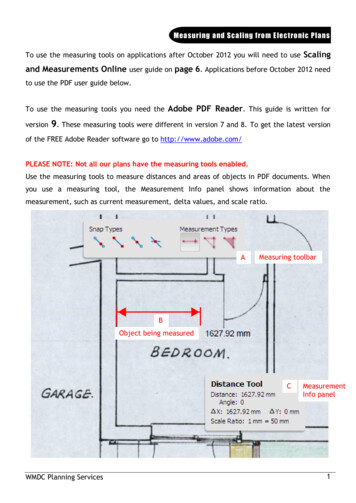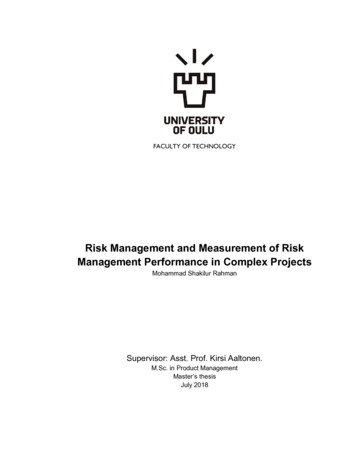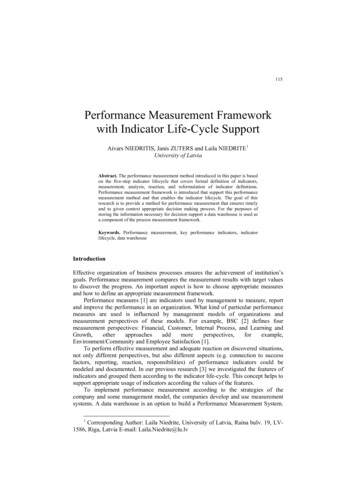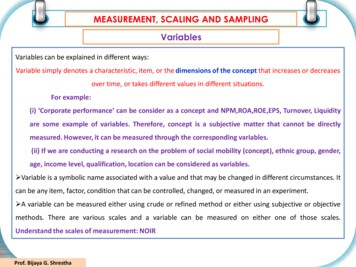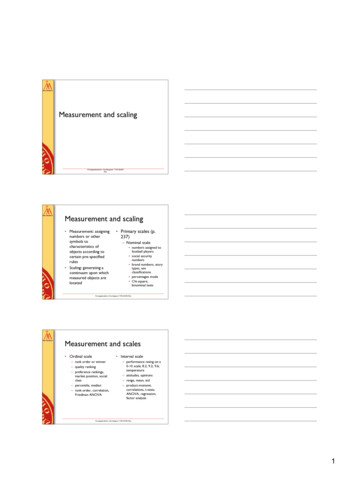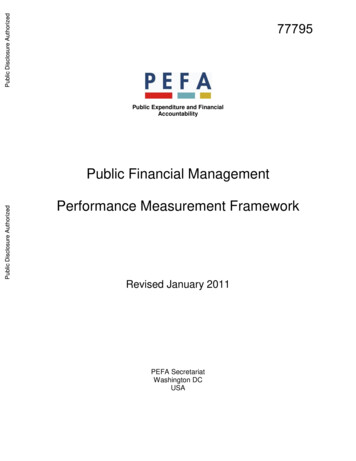
Transcription
Public Disclosure AuthorizedPublic Disclosure AuthorizedPublic Disclosure Authorized77795Public Expenditure and FinancialAccountabilityPublic Financial ManagementPerformance Measurement FrameworkPublic Disclosure AuthorizedRevised January 2011PEFA SecretariatWashington DCUSA
.PEFA - PFM Performance Measurement Framework - Revised January 2011PEFA is a multi-agency partnership program sponsored by:The World BankThe International Monetary FundThe European CommissionThe United Kingdom’s Department for International DevelopmentThe French Ministry of Foreign AffairsThe Royal Norwegian Ministry of Foreign AffairsThe Swiss State Secretariat for Economic AffairsPEFA Secretariat contacts:Address:PEFA Secretariat1818 H Street NWWashington DC 20433, USAEmail:Website:services@pefa.orgwww.pefa.orgii
.PEFA - PFM Performance Measurement Framework - Revised January 2011ForewordThere is wide agreement that effective institutions and systems of public financialmanagement (PFM) have a critical role to play in supporting implementation of policies ofnational development and poverty reduction. This PEFA PFM Performance MeasurementFramework – initially issued in June 2005 - has been developed as a contribution to thecollective efforts of many stakeholders to assess and develop essential PFM systems, byproviding a common pool of information for measurement and monitoring of PFMperformance progress, and a common platform for dialogue.The PEFA PFM Performance Measurement Framework incorporates a PFM performancereport, and a set of high level indicators which draw on the HIPC expenditure trackingbenchmarks, the IMF Fiscal Transparency Code and other international standards. It formspart of the Strengthened Approach to supporting PFM reform, which emphasizes countryled reform, donor harmonization and alignment around the country strategy, and a focus onmonitoring and results. This approach seeks to mainstream the better practices that arealready being applied in some countries.Drawing on experience from application of the Framework in more than 120 countries, theFramework has been updated by revising the content of three of the performanceindicators. The original development of the Framework as well as the revisions have beenundertaken by the Public Expenditure Working Group, which involves World Bank, IMFand PEFA staff, with direction and selected inputs provided by the PEFA SteeringCommittee. A public consultation on the revisions took place during June-July 2010.The PEFA program is pleased to re-issue the PEFA PFM Performance MeasurementFramework, with the revised indicators PI-2, PI-3 and PI-19, which are to be used for allassessments prepared after 28th February 2011. The original version of these indicators areincluded in Annex 3 for easy reference, as future users of the Framework may need tocompare to earlier assessments that have applied the original version of indicators.Further information on the Framework and the Strengthened Approach can be found at thePEFA website – www.pefa.org – along with guidance on the use of the Framework.iii
.PEFA - PFM Performance Measurement Framework - Revised January 2011iv
.PEFA - PFM Performance Measurement Framework - Revised January 2011Table of ContentsPage1.2.3.4.5.Introduction and backgroundScope and coverage of the frameworkThe set of high level performance indicatorsThe PFM Performance ReportOverall structure of the Performance Measurement Framework11456Annex 1Annex 2Appendix 1The PFM High-Level Performance Indicator SetThe PFM Performance Report75366Annex 3The original indicatorsPI-2PI-3PI-1969717273v
.PEFA - PFM Performance Measurement Framework - Revised January 2011List of mous Government AgenciesCompte Général de l‟Administration des FinancesClassifications of Functions of GovernmentDevelopment Assistance Committee of OECDGovernment Financial StatisticsInternational Auditing and Assurance Standards BoardInternational Federation of AccountantsInspection Générale des FinanceInternational Organization of Supreme Audit InstitutionsInternational Public Sector Accounting Standards (of IFAC)International Standards for the Professional Practice of Internal AuditorsMinistries, Departments and AgenciesMinistry of FinanceOrganisation for Economic Co-operation and DevelopmentPublic Financial ManagementPFM Performance ReportPerformance IndicatorPublic EnterpriseRevenue AdministrationSupreme Audit InstitutionSub-National (government)United States Dollarsvi
.PEFA - PFM Performance Measurement Framework - Revised January 2011The PFM Performance Measurement Framework1. Introduction and backgroundThe PFM Performance Measurement Framework is an integrated monitoring frameworkthat allows measurement of country PFM performance over time. It has been developed bythe PEFA partners, in collaboration with the OECD/DAC Joint Venture on PFM as a toolthat would provide reliable information on the performance of PFM systems, processes andinstitutions over time. The information provided by the framework would also contributeto the government reform process by determining the extent to which reforms are yieldingimproved performance and by increasing the ability to identify and learn from reformsuccess. It would also facilitate harmonization of the dialogue between government anddonors around a common framework measuring PFM performance and thereforecontribute to reduce transaction costs for partner governments.The PFM Performance Measurement Framework is one of the elements of a strengthenedapproach to supporting PFM reforms1. It is designed to measure PFM performance ofcountries across a wide range of development over time. The Performance MeasurementFramework includes a set of high level indicators, which measures and monitorsperformance of PFM systems, processes and institutions and a PFM Performance Report(PFM-PR) that provides a framework to report on PFM performance as measured by theindicators.2. Scope and coverage of the frameworkA good PFM system is essential for the implementation of policies and the achievement ofdevelopmental objectives by supporting aggregate fiscal discipline, strategic allocation ofresources and efficient service delivery. An open and orderly PFM system is one of theenabling elements for those three levels of budgetary outcomes: Effective controls of the budget totals and management of fiscal risks contribute tomaintain aggregate fiscal discipline. Planning and executing the budget in line with government priorities contributes toimplementation of government‟s objectives. Managing the use of budgeted resources contributes to efficient service deliveryand value for money.1The Strengthened Approach has three components (i) a country led PFM reform strategy and action plan,(ii) a coordinated IFI-donor integrated, multi-year program of PFM work that supports and is aligned with thegovernment‟s PFM reform strategy and, (iii) a shared information pool. The Performance MeasurementFramework is a tool for achieving the third objective.1
.PEFA - PFM Performance Measurement Framework - Revised January 2011The Performance Measurement Framework identifies the critical dimensions ofperformance of an open and orderly PFM system as follows2:1. Credibility of the budget - The budget is realistic and is implemented as intended2. Comprehensiveness and transparency - The budget and the fiscal risk oversightare comprehensive and fiscal and budget information is accessible to the public.3. Policy-based budgeting - The budget is prepared with due regard to governmentpolicy.4. Predictability and control in budget execution - The budget is implemented in anorderly and predictable manner and there are arrangements for the exercise ofcontrol and stewardship in the use of public funds.5. Accounting, recording and reporting – Adequate records and information areproduced, maintained and disseminated to meet decision-making control,management and reporting purposes.6. External scrutiny and audit - Arrangements for scrutiny of public finances andfollow up by executive are operating.Against the six core dimensions of PFM performance, the set of high-level indicatorsmeasures the operational performance of the key elements of the PFM systems,processes and institutions of a country central government, legislature and external audit.In addition, the PFM-PR uses the indicator-based analysis to develop an integratedassessment of the PFM system against the six critical dimensions of PFM performance andevaluate the likely impact of PFM weaknesses on the three levels of budgetary outcomes.The set of high-level indicators captures the key PFM elements that are recognized asbeing critical for all countries to achieve sound public financial management. In somecountries, the PFM-PR may also include an assessment of additional, country specificissues in order to provide a comprehensive picture of PFM performance.It is expected that the repeated application of the indicator tool will provide information onthe extent to which country PFM performance is improving or not. In addition, thePFM-PR recognizes the efforts made by government to reform its PFM system bydescribing recent and on-going reform measures, which may not have yet impacted PFMperformance. The report does not, however, include any recommendations for reforms orassumptions as to the potential impact of ongoing reforms on PFM performance.The focus of the PFM performance indicator set is the public financial managementat central government level, including the related institutions of oversight. Centralgovernment comprises a central group of ministries and departments (and in some casesdeconcentrated units such as provincial administrations), that make up a single institutionalunit. In many countries, other units are operating under the authority of the centralgovernment with a separate legal entity and substantial autonomy in its operations (in this2These core dimensions have been determined on the basis of what is both desirable and feasible to measureand define the nature and quality of the key elements of a PFM system captured by the set of high-levelindicators.2
.PEFA - PFM Performance Measurement Framework - Revised January 2011document referred to as autonomous government agencies) and also constitute a part ofcentral government operations. Such units would be used for the purpose of implementingcentral government policy and may include non-profit institutions, which are controlledand mainly financed by central government.Operations of other levels of general government and of public enterprises areconsidered in the PFM performance indicator set only to the extent they impact theperformance of the national PFM system and its linkages to national fiscal policy,formulated and monitored by central government (refer to PI-8, PI-9 and PI-23).Other parts of general government include lower levels with separate accountabilitymechanisms and their own PFM systems (e.g. budgets and accounting systems). Such subnational governments may include state, provincial, and regional government at a higherlevel and local government (including e.g. districts and municipalities) at a lower level. Inaddition to general government, the public sector includes public corporations orenterprises, created for the purpose of providing goods and services for a market, andcontrolled by and accountable to government units. Public corporations can be nonfinancial or financial, the latter including monetary corporations such as the central bank 3.Additional information on other levels of government and public enterprises may beincluded in the section on country specific issues of the PFM-PR.The focus of the indicator set is on revenues and expenditures undertaken throughthe central government budget. However, activities of central government implementedoutside the budget are covered in part by the indicators PI-7, PI-9, PI-26 and D-2.Typically, this includes expenditure executed by central government units and financedfrom earmarked revenue sources (whether domestic or external, the latter often being onlynominally on-budget), and by autonomous government agencies.The Performance Measurement Framework does not measure the factors impactingperformance, such as the legal framework or existing capacities in the government. Inparticular, the set of high-level indicators focuses on the operational performance of thekey elements of the PFM system rather than on the inputs than enable the PFM system toreach a certain level of performance.The Performance Measurement Framework does not involve fiscal or expenditure policyanalysis, which would determine whether fiscal policy is sustainable, whetherexpenditures incurred through the budget have their desired effect on reducing poverty orachieving other policy objectives, or whether there is value for money achieved in servicedelivery. This would require detailed data analysis or utilization of country-specificindicators. The framework rather focuses on assessing the extent to which the PFMsystem is an enabling factor for achieving such outcomes.3For further details of definition of the public sector and its sub-divisions, refer to the GFS Manualparagraphs 2.9-2.62 (Government Finance Statistics Manual, IMF 2001)3
.PEFA - PFM Performance Measurement Framework - Revised January 20113. The set of high level performance indicatorsThe selected 28 indicators for the country‟s PFM system are structured into threecategories:A. PFM system out-turns: these capture the immediate results of the PFM system interms of actual expenditures and revenues by comparing them to the originalapproved budget, as well as level of and changes in expenditure arrears.B. Cross-cutting features of the PFM system: these capture the comprehensivenessand transparency of the PFM system across the whole of the budget cycle.C. Budget cycle: these capture the performance of the key systems, processes andinstitutions within the budget cycle of the central government.In addition to the indicators of country PFM performance, this framework also includesD. Donor practices: these capture elements of donor practices which impact theperformance of country PFM system.A complete listing of the individual indicators is found at the beginning of Annex 1.The following diagram illustrates the structure and coverage of the PFM system measuredby the set of high level indicators and the links with the six core dimensions of a PFMsystem:C. Budget cycleD. Donor PracticesPolicy-basedbudgetingA. PFM Out-turnsExternalscrutinyand auditB. Key crosscutting yand control inbudgetexecutionAccounting,recordingand reporting4Budget credibility
.PEFA - PFM Performance Measurement Framework - Revised January 2011Each indicator seeks to measure performance of a key PFM element against a four pointordinal scale from A to D. Guidance has been developed on what performance would meeteach score, for each of the indicators. The highest score is warranted for an individualindicator if the core PFM element meets the relevant objective in a complete, orderly,accurate, timely and coordinated way. The set of high-level indicators is therefore focusingon the basic qualities of a PFM system, based on existing good international practices,rather than setting a standard based on the latest innovation in PFM.Annex 1 includes further information on the calibration and the scoring methodologyas well as detailed guidance for each of the indicators.4. The PFM Performance ReportThe objective of the PFM Performance report (PFM-PR) is to provide an assessment ofPFM performance based on the indicator-led analysis in a concise and standardizedmanner. Information provided by the PFM-PR would feed into the government and donordialogue.The PFM–PR is a concise document, which has the following structure and content: A summary assessment (to be at the beginning of the report) uses the indicator-ledanalysis to provide an integrated assessment of the country‟s PFM system against thesix core dimensions of PFM performance and a statement of the likely impact of thoseweaknesses on the three levels of budgetary outcomes, aggregate fiscal discipline,strategic allocation of resources and efficient service delivery. An introductory section presents the context and the process of preparing the reportand specifies the share of public expenditures captured by the report. A section presents country-related information which is necessary to understand theindicator-led and overall assessment of PFM performance. It includes a brief review ofthe country economic situation, a description of the budgetary outcomes as measuredby achievement of aggregate fiscal discipline and strategic allocation of funds4 and, astatement on the legal and institutional PFM framework. The main body of the report assesses the current performance of PFM systems,processes and institutions based on the indicators, and describes the recent and ongoing reform measures implemented by government. A section on government reform process briefly summarizes recent and ongoingreform measures implemented by government and assesses the institutional factors thatare likely to impact reform planning and implementation in the future.As mentioned above, the report is a statement of current PFM performance and does notinclude recommendations for reforms or action plans. In case of different views betweenthe donors and the government over the findings of the report, the government‟s opinioncould be reflected in an annex of the report.Annex 2 provides additional information and guidance on the PFM-PR.4As drawn from other analytical work.5
.PEFA - PFM Performance Measurement Framework - Revised January 20115. Overall structure of the Performance Measurement FrameworkThe structure of the Performance Measurement Framework is summarized below:Analytical Framework underpinning thePerformance Measurement FrameworkThe assessment provided by the PerformanceMeasurement FrameworkAn open and orderly PFM systemsupportsAssessment of the extent to which theexisting PFM system supports theachievement of aggregate fiscal discipline,strategic allocation of resources andefficient service delivery. Aggregate fiscal discipline Strategic allocation of resources Efficient service deliveryThe core dimensions of an open andorderly PFM system are:Assessment of the extent to which PFMsystems, processes and institutions meetthe core dimensions of PFM performance. Credibility of the budgetComprehensiveness and transparencyPolicy-based budgetingPredictability and control in budgetexecution Accounting, recording and reporting External scrutiny and auditThe indicators measure theoperational performance of the keyelements of the PFM system againstthe core dimensions of PFMperformanceThe key elements of the PFM systemmeasure the core dimensions of PFMperformanceSee the list of indicators6
.PEFA - PFM Performance Measurement Framework - Revised January 2011Annex 1The PFM High-Level Performance Indicator Set7
.PEFA - PFM Performance Measurement Framework - Revised January 20118
.PEFA - PFM Performance Measurement Framework - Revised January 2011Annex 1The PFM High-Level Performance Indicator SetOverview of the indicator setA. PFM-OUT-TURNS: Credibility of the budgetPI-1PI-2PI-3PI-4Aggregate expenditure out-turn compared to original approved budgetComposition of expenditure out-turn compared to original approved budgetAggregate revenue out-turn compared to original approved budgetStock and monitoring of expenditure payment arrearsB. KEY CROSS-CUTTING ISSUES: Comprehensiveness and n of the budgetComprehensiveness of information included in budget documentationExtent of unreported government operationsTransparency of inter-governmental fiscal relationsOversight of aggregate fiscal risk from other public sector entities.Public access to key fiscal informationC. BUDGET PI-20PI-21PI-22PI-23PI-24PI-25PI-26PI-27PI-28C(i) Policy-Based BudgetingOrderliness and participation in the annual budget processMulti-year perspective in fiscal planning, expenditure policy and budgetingC(ii) Predictability and Control in Budget ExecutionTransparency of taxpayer obligations and liabilitiesEffectiveness of measures for taxpayer registration and tax assessmentEffectiveness in collection of tax paymentsPredictability in the availability of funds for commitment of expendituresRecording and management of cash balances, debt and guaranteesEffectiveness of payroll controlsCompetition, value for money and controls in procurementEffectiveness of internal controls for non-salary expenditureEffectiveness of internal auditC(iii) Accounting, Recording and ReportingTimeliness and regularity of accounts reconciliationAvailability of information on resources received by service delivery unitsQuality and timeliness of in-year budget reportsQuality and timeliness of annual financial statementsC(iv) External Scrutiny and AuditScope, nature and follow-up of external auditLegislative scrutiny of the annual budget lawLegislative scrutiny of external audit reportsD. DONOR PRACTICESD-1D-2D-3Predictability of Direct Budget SupportFinancial information provided by donors for budgeting and reporting on project and program aidProportion of aid that is managed by use of national procedures9
.PEFA - PFM Performance Measurement Framework - Revised January 2011Scoring MethodologyMost of the indicators have a number of dimensions linked to the subject of the indicator.Each of these dimensions must be assessed separately. The overall score for an indicator isthen based on the assessments for the individual dimensions of the indicator. Combiningthe scores for dimensions into the overall score for the indicator is done by ScoringMethod 1 (M1) for some indicators and Scoring Method 2 (M2) for other indicators. It isspecified in the indicator guidance for each indicator what methodology should be used.Method 1 (M1) is used for all single dimensional indicators and for multi-dimensionalindicators where poor performance on one dimension of the indicator is likely toundermine the impact of good performance on other dimensions of the same indicator (inother words, by the weakest link in the connected dimensions of the indicator). Forindicators with 2 or more dimensions, the steps in determining the overall or aggregateindicator score are as follows: Each dimension is initially assessed separately and given a score. Combine the scores for the individual dimensions by choosing the lowest score givenfor any dimension. A „ ‟ should be added, where any of the other dimensions are scoring higher (Note: Itis NOT possible to choose the score for one of the higher scoring dimensions and add a„-„ for any lower scoring dimensions. And it is NOT possible to add a „ ‟ to the scoreof an indicator with only one listed dimension).Method 2 (M2) is based on averaging the scores for individual dimensions of an indicator.It is prescribed for selected multi-dimensional indicators, where a low score on onedimension of the indicator does not necessarily undermine the impact of a high score onanother dimension of the same indicator. Though the dimensions all fall within the samearea of the PFM system, progress on individual dimensions can be made independent ofthe others and without logically having to follow any particular sequence. The steps indetermining the overall or aggregate indicator score are as follows: For each dimension, assess what standard has been reached on the 4-point calibrationscale (as for M1). Go to the Conversion Table for Scoring Method M2 (below) and find the appropriatesection of the table (2, 3 or 4 dimensional indicators), Identify the line in the table that matches the combination of scores that has been givento the dimensions of the indicator (the order of the dimensional scores is immaterial), Pick the corresponding overall score for the indicator.The Conversion Table applies to all indicators using M2 scoring methodology only andcannot be used for indicators using M1, as that would result in an incorrect score. TheConversion Table should NOT be used to aggregate scores across all or sub-sets ofindicators, since the table was not designed for that purpose. In general, the performanceindicator set has not been designed for aggregation, and therefore, no aggregationmethodology has been developed.10
.PEFA - PFM Performance Measurement Framework - Revised January 2011Conversion Table for Scoring Method M2Overall scoreScores forM2individual dim.2-dimensional indicatorsDDDDCD DBCDAC CCCCBC CABBBBBAB AAA3-dimensional indicatorsDDDDDDCD DDBD DDACDCCD DCBCDCAC DBBC DBABDAABCCCCCCBC CCABCBBBCBABCAAB BBBBBBAB BAAAAAAAOverall scoreScores forM2individual dim.4-dimensional indicatorsDDDDDDDDCDDDDBD DDDAD DDCCD DDCBD DDCACDDBBCDDBAC DDAAC DCCCD DCCBCDCCAC DCBBC DCBAC DCAABDBBBC DBBABDBAABDAAAB CCCCCCCCBC CCCAC CCBBC CCBABCCAABCBBBBCBBABCBAAB CAAAB BBBBBBBBAB BBAAB BAAAAAAAAANote: It is of no importance inwhich order the dimensions in anindicator are assigned theindividual scoresThe table CANNOT be applied to indicators using scoring method M1.11
.PEFA - PFM Performance Measurement Framework - Revised January 2011General Guidance on ScoringIn order to justify a particular score for a dimension of an indicator, all the requirementsspecified for that score in the scoring table must be fulfilled. However, there are caseswhere a score can be justified by alternative requirements, in which case the alternativesare separated by the word „OR‟.The „D‟ score is considered the residual score, to be applied if the requirements for anyhigher score are not met. While the calibration of each dimension of an indicator (i.e. theminimum requirements for a particular score) includes a description also of the „D‟ scorerequirements, there may be cases where the actual situation does not fit reasonably wellinto this description, even if the requirements for any higher score are not met. In that casea „D‟ score should be allocated and the difference between the score requirements and theactual situation be commented in the narrative.The requirements for a score can be assessed on the basis of different time horizons. Therelevant period on which a dimension should be assessed, and therefore for which evidenceshould be sought, is specified in the guidance or calibration for manyindicators/dimensions. Where it is not specified, it should be assessed on the basis of thecurrent situation, or in the case of periodic events, on the basis of the events during themost recent budget cycle.Indicators PI-1, PI-2, PI-3 and D-1 require data for three years as a basis for theassessment. The data should cover the most recent completed fiscal year for which data isavailable and the two immediately preceding years. The assessment is based on theperformance in two out of those three years i.e. allowance is made for one year to beabnormal (and not contributing to the score) due to unusual circumstances such as externalshocks (e.g. natural disasters, price fluctuations in important export or importcommodities) or domestic problems (e.g. of a political nature). As such anomalies havegenerally been catered for in the calibration, no fiscal year should be skipped in the basicdata set.Further guidance on scoring will be made available on the website www.pefa.org,including answers to frequently asked questions.Specific Guidance on Each IndicatorThe remainder of this Annex 1 provides detailed guidance on the scoring of each of theindicators including the scoring tables for each indicator.Guidance on the narrative reporting on each indicator is provided in the Box inserted inSection 3 of Annex 2.12
.PEFA - PFM Performance Measurement Framework - Revised January 2011PI-1. Aggregate expenditure out-turn compared to original approved budgetThe ability to implement the budgeted expenditure is an important factor in supporting thegovernment‟s ability to deliver the public services for the year as expressed in policy statements,output commitments and work plans. The indicator reflects this by measuring the actual totalexpenditure compared to the originally budgeted total expenditure (as defined in governmentbudget documentation and fiscal reports), but excludes two expenditure categories over which thegovernment will have little control. Those categories are (a) debt service payments, which inprinciple the government cannot alter during the year while they may change due to interest andexchange rates movements, and (b) donor funded project expenditure, the management andreporting of which are typically under the donor agencies‟ control to a high degree.In order to understand the reasons behind a deviation from the budgeted expenditure, it is importantthat the narrative describes the external factors that may have led to the deviation and particularlymakes reference to the impact of deviations from budgeted revenue, assessed by indicators PI-3(domestic revenue) and D-1 (external revenue). It is also important to understand the impact of atotal expenditure deviation on the ability to implement the expenditure composition as budgeted,ref. also PI-2 and PI-16.Dimension to be assessed (Scoring Method M1):(i) The difference between actual primary expenditure and the originally budgeted primaryexpenditure (i.e. excluding debt service charges, but also excluding externally financedproject expenditure).ScoreABCDMinimum Requirements (Scoring Method M1)(i) In no more than one out of the last three years has the actual expenditure deviatedfrom budgeted expenditure by an amount equivalent to more than 5% of budgetedexpenditure.(i) In no more than one out of the last three years has the actual expenditure deviatedfrom budgeted expenditure by a
PEFA - PFM Performance Measurement Framework - Revised January 2011 . 2 The Performance Measurement Framework identifies . the critical dimensions of performance of an open and orderly PFM system . as follows. 2: 1. Credibility of the budget - The budget is realistic and is implemented as intended 2. Comprehensiveness and transparency


